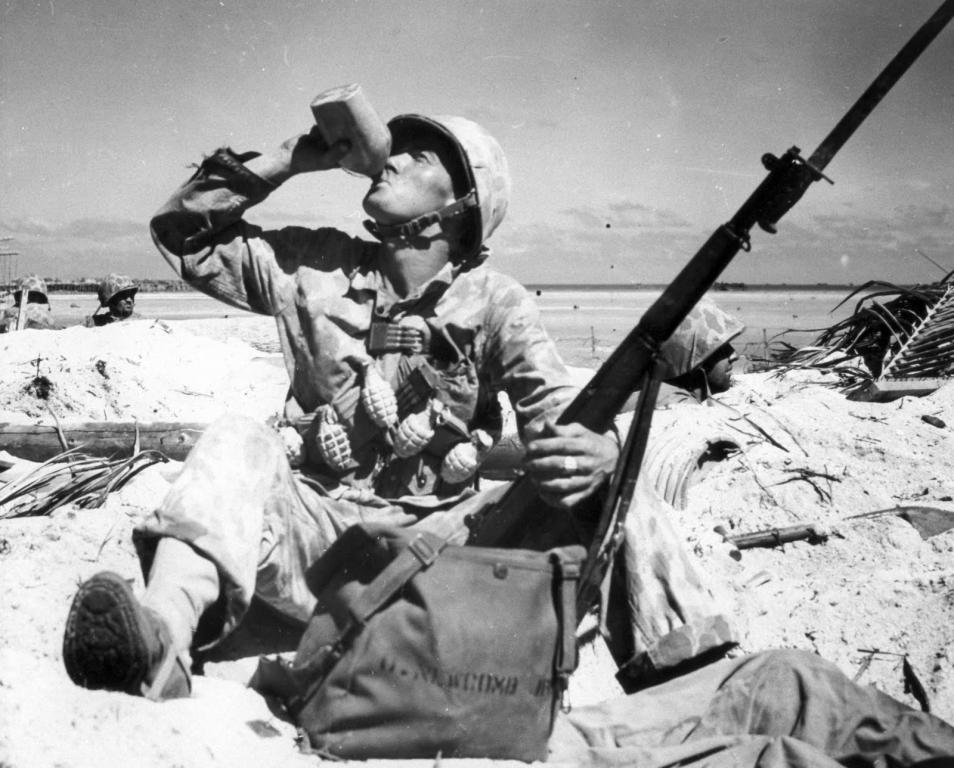-
Contributing Member


12-271 Garand Picture of the Day

Information
 |
Warning: This is a relatively older thread
This discussion is older than 360 days. Some information contained in it may no longer be current. |
|
He is no fool who gives what he cannot keep to gain that which he cannot lose
There are no great men, only great challenges that ordinary men are forced by circumstances to meet.
-
The Following 14 Members Say Thank You to Mark in Rochester For This Useful Post:
30-06_mike,
AZPhil,
Bill Hollinger,
Bill Hughes,
Bob Womack,
cgroc09,
frankderrico,
HOOKED ON HISTORY,
rayg,
RudyN,
Sarge1998,
sjc,
Thaine,
xa-coupe
-
09-30-2012 11:55 AM
# ADS
Friends and Sponsors

-
FREE MEMBER
NO Posting or PM's Allowed

That bayonet looks extra long. But I'm no expert on them. Don't even have one.
-
Legacy Member

That Devil Dog definatly looks like he is ready to Take Care Of Business!!!!!
I love the last name on his bag
"NEWCOMB"
I guess we did Nuke em at the end!!!!
Last edited by AZPhil; 09-30-2012 at 09:49 PM.
-
Thank You to AZPhil For This Useful Post:
-
Legacy Member

There's a bayonet made in 42 that was full length which is probably one of these. I would expect that a large amount would have been shortened but they would have been out and about. I believe that the 42 build was the only time they made full length ones for the Garand .. all from memory so someone who does have a clue can correct me
.. all from memory so someone who does have a clue can correct me 
-
-
Legacy Member

Not so rare, 1,540,000 of the m1905 bayonets were made in 42-43
-
-
Advisory Panel


The long bayonets were the standard issue for the USMC for the first while. It took a while for them to be cut down and also to produce the M1 blade. The appearance of the 16" blade isn't unusual at all for the island fighters.
blade. The appearance of the 16" blade isn't unusual at all for the island fighters.
-
-
FREE MEMBER
NO Posting or PM's Allowed

-
Advisory Panel


-
Thank You to browningautorifle For This Useful Post:
-
Senior Moderator
(Milsurp Forums)


Note that BAR's M1905 is parkerized. I believe this was started in 1918. Prior to that the blades were in the white. I have a S/A 1912 and S/A 1914. Both blades are in the white. I have a 1942 PAL with Bakelite handles and a parkerized blade. I think the Bakelite grips started sometime in the 1930s.
Bill Hollinger
"We're surrounded, that simplifies our problem!"
-
-
Contributing Member



Originally Posted by
Bill Hollinger

Note that BAR's M1905 is parkerized. I believe this was started in 1918. Prior to that the blades were in the white. I have a S/A 1912 and S/A 1914. Both blades are in the white. I have a 1942 PAL with Bakelite handles and a parkerized blade. I think the Bakelite grips started sometime in the 1930s.
Bayo Point 23 reference:
The Grips:
Experiments had been made with plastic grip materials beginning in late 1941, and by April 1942 it had been determined that the grip material would be "a material similar to Durez No. 1905 with Rogers Board insert" (from United States Army Edged Weapons Report 1917-1945). Durez is a brand name of Phenol-Formaldehyde resin similar to Bakelite. Shortly afterward (June 29, 1942) this specification was written to include other similar thermoplastic resins as Plastic Bayonet Grips, Grade B of SXS-103 Phenolic-Molded Shapes for Small Arms Components. This material is often generically called Bakelite, although that is a brand name rather than a chemical name.
Army Edged Weapons Report 1917-1945). Durez is a brand name of Phenol-Formaldehyde resin similar to Bakelite. Shortly afterward (June 29, 1942) this specification was written to include other similar thermoplastic resins as Plastic Bayonet Grips, Grade B of SXS-103 Phenolic-Molded Shapes for Small Arms Components. This material is often generically called Bakelite, although that is a brand name rather than a chemical name.
As this resin was expected to at times be in short supply, tests continued to be conducted of other plastic materials at Springfield Armory. Cellulose Acetate Butyrate (commonly called CAB) was allowed as an alternative material. After some time in field use, it was reported that CAB was not resistant to the solvents used to degrease the bayonets in the field and would dissolve the grips. About 100,000 CAB grips were manufactured before they were discontinued due to this problem in April 1943. From available evidence, it appears that most of these grips were used by AFH, with possibly some going to other makers. According to the edged weapons report quoted above, "Except for the disruption of production that would ensue for about one month while American Fork and Hoe Company was arranging for procurement of the other type of plastic, there was no reason for the continuing of cellulose acetate grips."
There are four makers of the bayonet grips in WW2 (possibly more, as one or two other marks have been noted but are so uncommon as to call into question their use in WW2). For many years I have been trying to identify the makers of the grip, including asking for help in a previous Bayonet Points column. Unfortunately, no one was able to be of assistance. Three of the makers of the grips are identified only by a logo or initials molded into the plastic - the other is entirely unmarked.
-
Thank You to Sarge1998 For This Useful Post:
 Information
Information















 PM
PM











